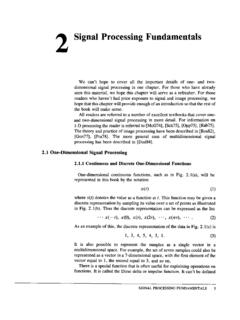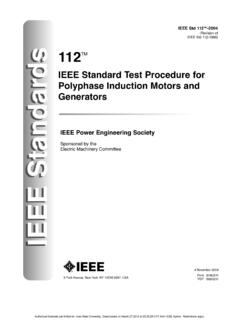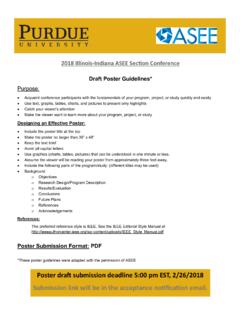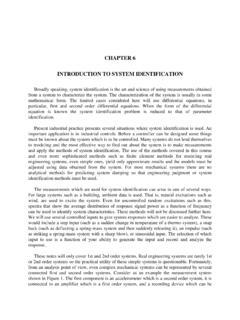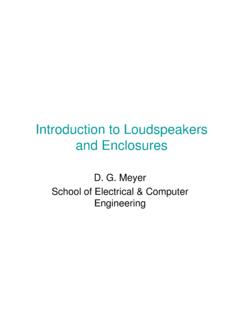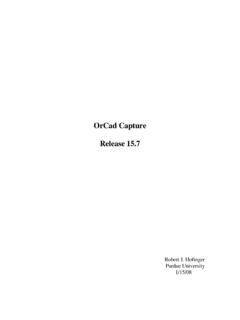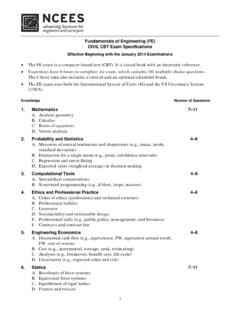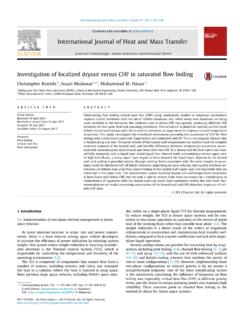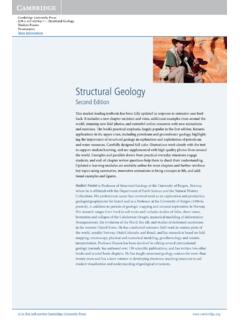Transcription of CE -474: Structural Analysis II - Purdue University
1 CE-474: Structural Analysis II(Instructor: Arun Prakash)Determine the "response" or behavior of a structure under some specified loads or combinations of loads Response includes: support reactions, internal stresses, and deformations / displacements It can also include: vibrations, stability of components / system, state of the constituent materials, occurrence of damage / failure etc. What is Structural Analysis ?Why is Structural Analysis needed and how does it fit into the "Big Picture?"(Role of Structural Analysis in the Design Process)Consider a design project: say BridgeType of bridge Traffic/Live Load, EQ, Winds, Snow, Stream Ice Temperature Thermal Impact / Blast* Fatigue Design Life ~50 years Loading classification Things to consider:Assume a solution (based on experience, requirements) Preliminary Structural Analysis Refine the design Check with detailed Structural Analysis Design Process ASD 5 Allowable Stress Design LRFD 5 Load & Resistance factor design Designs methodologies Material / Construction costs Performance5based criteria Choose design parameters (criteria)It can be framed as an optimization problem also: Note: Design is an inverseproblem.
2 It has many possible Beam bridgeTrussSuspensionCable5stayedArch IntroReview Page 1 Structure Geometry, Loading, Material properties Support (boundary) conditions Given:External reactions Internal stresses and stress5resultants (axial force, shear force, bending moment) Deflections / displacements Strains Material response To find:(unknowns at each and every point of the structure): Statics: Equilibrium of Forces and of & Initial / Governing Equations to satisfy using Structural Analysis :Problem Statement for Structural AnalysisForce (flexibility) method Displacement (stiffness) method Methods of Structural AnalysisPlate and Shell structuresLarge Continuum StructuresComplex assembly of componentsIndeterminateDeterminateWhat about other types of structures? IntroReview Page 2 Statics: Equilibrium of Forces and MomentsPoint particles Rigid bodies Deformable bodies Statics for:Consider the frame of both pulleys = mExampleIs the frame statically determinate?
3 The axial force, shear force and bending moment diagram for member shape IntroReview Page 3 Statics: Equilibrium of Deformable BodiesPlate and Shell structuresLarge Continuum StructuresComplex assembly of componentsOr even our beloved simply supported beam:Stress IntroReview Page 4 Concepts of Traction and Stress In general,Tractionis the distributed force per unit area acting at a pointon any (external) surface of a body or a part of a is a vector represented with a 3x1 matrix in a physical quantity that completely characterizes the distributed internal forces per unit area that develop at a pointwithin a body or a part of a body, at any orientation of the internal surface. Stress is a tensorand is represented with a 3 x 3 like a 3 3 matrix multiplied with a 3 1 vector gives another 3 1 vector.)(Note: A tensor operates upon a vector to give another vector; Example: Truss memberAlso, Alternate cutCauchy Stress5traction relationship IntroReview Page 5 Transformation of stress(Change of co5ordinate axes)Also represented with Mohr's circlesRecall that a vector is represented with a 3 1 matrix.
4 The components of this 3 1 vector depend upon the choice of :Thus, using the Cauchy5stress relationshipThe transformed components of stress can be obtained as: IntroReview Page 6 Equilibrium equations in terms of stresses IntroReview Page 7 Stress Resultants (Axial force, Shear force, Bending Moment)Stress Resultants and Equilibrium for BeamsEquilibrium in terms of Stress ResultantsConsider a small x length of any beamcarrying a distributed of x element: IntroReview Page 8 Concept of StrainStrainis a physical quantity that measures these changes in shape and size at a pointin a body. Under the action on external "loads", any deformable body undergoes changes in its shape and size.( deforms).ExampleMore precisely:In general Displacements:Strain(tensor):(under smalldisplacements / deformations) IntroReview Page 9 Compatibility of strainsDisplacement5strain relationshipsNormal StrainsShear StrainsShear angleCompatibility conditions: IntroReview Page 10 Stress5strain relationship (Material behavior)One of the simplest material behavior is characterized by the linear5elastic Hooke's law(model).
5 In lDIn general a 3D linear5elastic material model is characterized by 2 material constants (properties):E: Young's Modulus : Poisson's RatioFor 3D material behavior: IntroReview Page 11 2D Plane Problems IntroReview Page 12 Final Problem Statement of Structural AnalysisFor most practical problems, analytical (exact) solutions to the above system of PDEs, are not possible to obtain. make simplifying assumptions, obtain approximate solutions to the above PDEs using numerical techniques like the finite element method. Structural engineers resort to Note: IntroReview Page 13 Structural Mechanics: Beam theoryKinematic Assumption: Assume that a beam consists of infinitely many RIGID CROSS5 SECTIONS that are connected with a FLEXIBLE STRING (at their centroids).Under this assumption consider a Mx length of the beam:.Pure BendingPureShearPureAxialActual response is some combination of all 3 "modes.
6 "The theory that accounts for all 3 modes of deformation above is called the Timoshenko Beam Theory. This theory is more general and is more suitable for "deep" / "short" beams beams whose depth/length ratio is less than 5. This is because for such beams bending deformations ane small and shear deformations contribute significantly to the response. An alternative theory which neglects the shear deformation is called the Bernoulli5 Euler Beam theory. This theory is applicable only to "long" / "slender" beams whose depth / length ratio is greater than 10. For such beams, the bending deformations are much larger in comparison to the shear deformations, so neglecting shear deformations is : IntroReview Page 14 If we further assume that shear deformations are negligible, then:Negligible Shear Deformations Assumption:(Curvature)(Osculating Circle)Furthermore:Finally this leads to the well known beam equations:and IntroReview Page 15 DeflectionsAnalyzing the loads and support conditions Bending moment diagram (using +/5curvatures and inflection points) Deflected shape (elastic curve) can be sketched by:ExamplesCalculating Deflections(Ref: Chapter 8)Sign Convention Shear: Left Down & Right Up(Smiley: positive)Moment.
7 Left Counter & Right Clockwise IntroReview Page 16 Examples IntroReview Page 17 Double IntegrationDeflected shapes of beams can also be calculated precisely by integrating the governing equation of beam equilibrium:.Constants are evaluated using boundary and compatibility conditions at supports or interior points. If M(x) diagram is discontinuous or has discontinuous changes in slope, then a single equation will not be possible for deflections and all segments would have to be integrated separately. Note:Example: IntroReview Page 18 Example: IntroReview Page 19 In addition, overall deflected shape and internal stresses and stress resultants have also been calculated. IntroReview Page 20 Moment5 Area TheoremsAn alternative to the double integration method is to use a semi5graphical method involving moment5area in situations where there are multiple segments of the beam (with different M/EI functions) that would lead to several boundary / continuity conditions to be solved for each segment.
8 Usually this method doesn't give the slope or deflection directly. You have to use a geometrical construction in terms of the unknowns to solve for :The change in slope of the deflected shape (elastic curve) of a beam between two points A and B is equal to the area under the M/EI diagram between these 1(Single integration)Note: is positive at tip of cantilever with tip load:Slope at the ends of a simply supported beam with center point load: IntroReview Page 21 For any two points A and B on a beam, the vertical distance between the tangents from A and from B at a third point C is equal to the 1st moment of areaunder the M/EI diagram between A and B taken about point 2(dtC= )(Hibbeler)Tangents from A and B measured at CExamples IntroReview Page 22 ExampleNote: This method does not give us an expression/equation for the slope or deflection at ALLpoints of the beam (as required by the general Problem statement of Structural Analysis ), whereas the method of double integration , one can find extremal values of slopes and deflections using this method, and usually these are sufficient for Structural Analysis and Design.
9 Is small => IntroReview Page 23 Example IntroReview Page 24 Conjugate Beam AnalogyThe conjugate beam methodanalogy relies simply on the similarities between the governing equations of beam theory and those of beam , for computation of slopes and displacements:LoadingReactionsShear Force DiagramBending Moment DiagramSlopesDisplacements(Double Integration)(Statics)In the Conjugate Beam Analogy:REAL CONJUGATEIn addition, Boundary and Interior conditionsExample IntroReview Page 25 Boundary and Interior conditions for Conjugate BeamsExamplesREAL CONJUGATE IntroReview Page 26 Example IntroReview Page 27 IntroReview Page 28 Determine the slope and deflection at C using the conjugate beam : IntroReview Page 29
